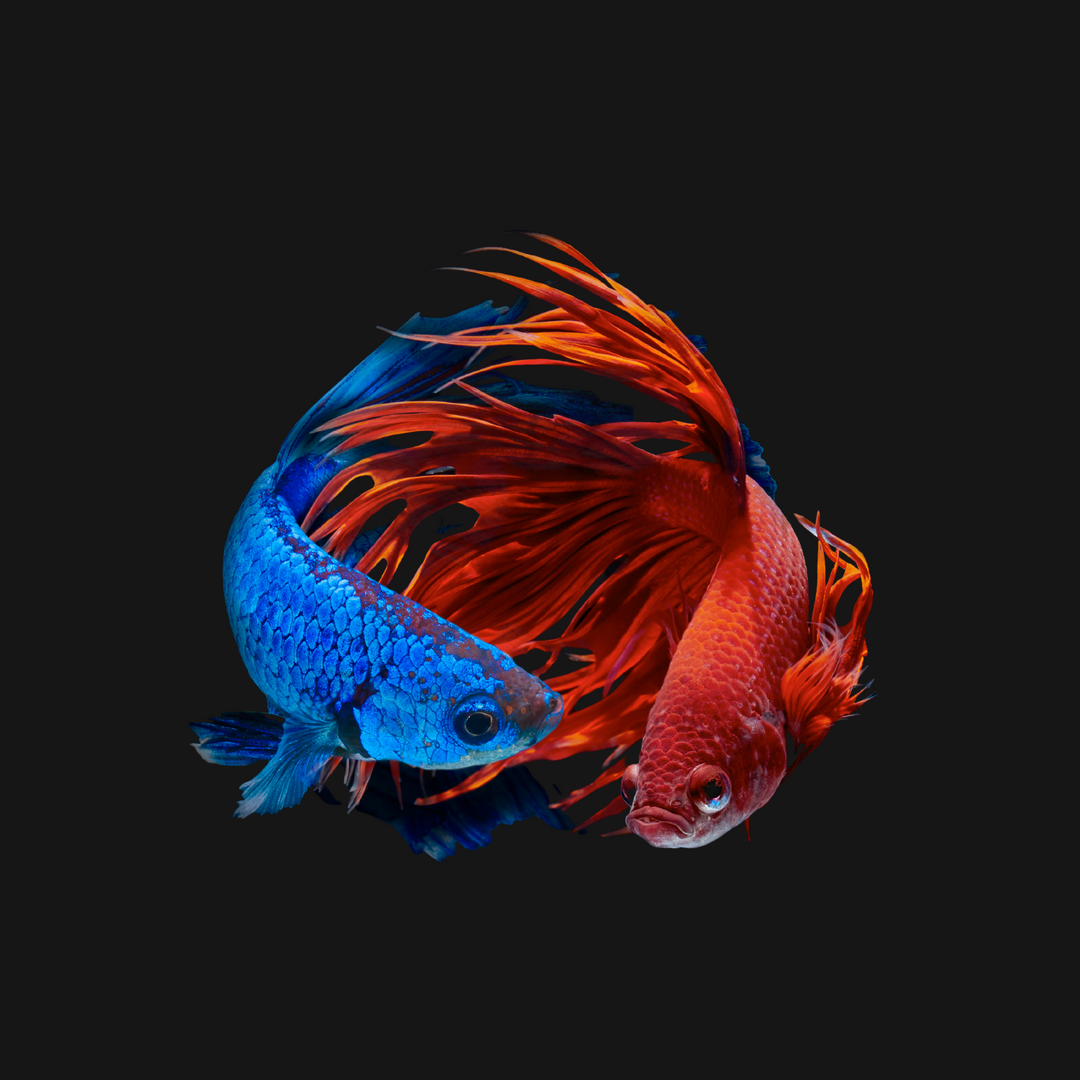Giant Betta Types

If you are an aquarium enthusiast considering purchasing a giant betta for your tank, you have probably come across many types of giant betta available. Each type has its unique color and fin characteristics. This complete guide will explore the main types of giant betta, talking about their distinctions and peculiarities.
FAQ
The Giant Betta
Giant Bettas are an impressive variety of Betta Splendens. Created by artificial selection by skilled breeders, this fish is the largest variety of bettas available on the market. It is a coveted fish due to its imposing size (up to 5 inches), vibrant colors, and exuberant fins.
They are resistant fish with curious behavior. Their care and needs are the same as other ornamental bettas. They should be kept at a pH of around 7.0 and in water around 75 F.
Giant Betta Types
As giant bettas are fish created in captivity, many characteristics, patterns, and colors were, and still are, developed. This constant improvement of fish leads to more and more different types flooding the aquarium trade and consequently the world.
Now let's talk about the main types of giant betta based on the shape of their fins.
Halfmoon Giant Betta
Giant 'halfmoon' betta is one of the most popular and well-known types of betta. The striking characteristic of this variety is its tail, which opens 180 degrees, resembling a half-moon. This feature gives it a spectacular look when the fish is displayed all open.
This fish was selected in aquariums in the late 1980s from common bettas. In giant bettas, Thai breeders quickly developed halfmoon strains soon after isolating the longtail tract in the first giants.
These fish display all the typical betta colors. Red, blue, and metallic tones such as bronze and white, or iridescent colors such as silver are common colors to find in these beautiful fish.
Colors can also bring a greater classification to these fish, as certain combinations are cataloged in the aquarium hobby. An example of this is halfmoon koi, or giant koi betta, where 'koi' alludes to the color of the fish.
To be considered a halfmoon fish, the most important thing is to have the tail opening at 180 degrees. This is the characteristic that names the variety, but there are other characteristics to be observed. The fins, as well as the body of the fish, must be symmetrical, presenting a harmonious body and fins equal and in proportion to the size of the fish's body.
The fin lines are also symmetrical, extending from the base of the fins. Proportion is an important characteristic, and in halfmoon bettas, the width of the tails concerning the length of the body follows the ratio of 1:15. These details are vital for these giant bettas to have elegance and balanced characters.
It is worth noting that giant halfmoon bettas, due to their large caudal fins, are not good swimmers and should never be placed in aquariums with a strong water flow.
Distinguishing male and female giant halfmoon bettas is easy, as females are less colorful and have less showy fins.
Learn more about the differences between male and female giant bettas here
Plakat Giant Betta
This was the first type of giant betta obtained by breeders and is the fish with the closest characteristics to wild Betta splendens fish. They are fish made to fight, but even so, their beauty has won over many hobbyists. Plakat type is similar to a giant wild betta.
Giant betta plakat have short, rounded fins, with a robust, stocky body. They are probably the most hardy betta variety. Thanks to their compact body, they are excellent swimmers.
This type of giant betta has pelvic fins that end in a pointed shape, with circular-shaped dorsal fins and elongated anal fins. Its dorsal fins are distinct and short, positioned on the furthest part of its back. Its mouth is turned upwards. These characteristics make these creatures fascinating.
Plakat are known for their curious and active personality. These giant bettas like to observe and explore their environment, making them a dynamic and captivating addition to the aquarium.
Like other giant bettas, plakats come in many colors, like giant galaxy koi betta and giant hellboy betta. Some varieties are monochromatic with a pronounced shine, reminiscent of wild fish, and others are highly colorful, showing the work carried out by artificial selection. This variety of colors allows aquarists to choose fish that suit their preference.
Among many types of plakat of ornamental lineage, we find a dragon, samurai, nemo, mustard fish, etc. These categories include the colors and arrangement of the scales of the giant plakat betta.
One advantage of plakat giant bettas is that they are very hardy and easy to care for. They have the same water requirements as other giant bettas, and some individuals can be quite aggressive.
We have a complete guide about keeping giant bettas in an aquarium. Check it out here.
Differentiating giant plakat bettas between males and females is not always precise. Female betta plakat fish can also display showy colors just like males. If you have any doubts, the best way is to differentiate them by behavior. Male fish are more aggressive and territorial than females, in addition to building a bubble nest.
Giant Crowntail Betta
Giant crowntail bettas are known for their ray fins sticking out. The fins are the most notable feature of giant crowntail bettas. All of the fish's fins have pointed, irregular ends resembling a crown when fully open. This distinctive feature creates a striking appearance for the fish.
Its caudal fin is often huge about its body. Like other giant bettas, crowntails are available in several colors, mainly dark shades of blue and red.
In this variety, the symmetry between the fins is essential, as is the proportion, number, and rays distance. The number of rays is even used as a characteristic of these fish, having their nomenclature:
SR (SingleRay) - only one ray per spike;
DR (Double Ray) - two rays on each spike;
TR (Triple Ray) - three rays on each spike;
DDR (Double Double Ray) - double rays on each spike;
CR (CrossRay) - when the tips of the rays cross;
RR (Random Ray).
Ideally, the crowntail variety is characterized by fins with complete and symmetrical spikes. The pointed ends of the fins should be well-defined and the tails should extend from the body by at least one-third of the length.
Giant crowntail Betta is certainly an outstanding fish in any fish keeper's collection.
Distinguishing their sex is easy, as the sexes have the same characteristics as Betta splendens, where males are larger and have more developed colors and fins.
FAQ
1. Are giant crowntail bettas aggressive like other betta varieties?
Yes, giant crowntail bettas are aggressive like other betta varieties and will show aggression when kept with other bettas or with fish of similar color or shape.2. What is the average size of a giant betta?
The average size of a giant betta is around 5 inches as adults.3. Do different types of giant betta have different care needs?
In general, no, different types of giant bettas do not have different care needs. Everyone needs an aquarium with a heater and filtration system, as well as water that is always in good condition and with stable parameters, ideal for the fish.4. Can I keep more than one giant betta in the same aquarium?
Never keep more than one giant betta in the same aquarium. These fish are aggressive and territorial and will fight for territory. It is preferable to keep them separated or with peaceful companions.5. What is the life expectancy of different types of giant bettas?
The life expectancy of different types of giant betta is the same, around 2 years.6. How can I distinguish a giant crowntail betta from other betta varieties?
You can distinguish a giant crowntail betta from other betta varieties by its spiked tail.7. Where to buy giant betta?
If you are interested in acquiring King or Giant Betta fish, we invite you to explore our distinguished Giant Betta Collection.










Leave a comment